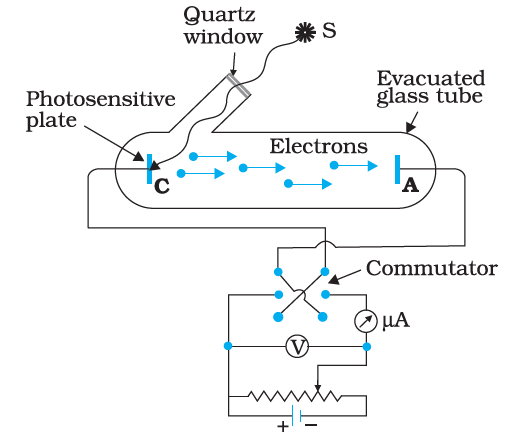
In photoelectric effect, the number of photoelectrons emitted is proportional to
A) velocity of incident beam
B) frequency of incident beam
C) intensity of incident beam
D) work function of cathode material.
Answer
472.8k+ views
Hint:The photoelectric effect is the phenomenon in which some materials emit electrons in the presence of light.
Hallwach Lenard’s experiment on photoelectric effect successfully helped in confirming Einstein's theory of photoelectric effect.
Complete step-by-step answer:
Here is the experimental setup for the photoelectric experiment for the study of photoelectric effect:

The experimental setup consists of an evacuated glass tube in which there are two electrodes. There is a quartz window which allows the light source through the glass tube. The electrodes are connected to a commutator which is used for changing the direction of the electric current.
One such experiment performed is the effect of intensity on photocurrent –
The collector anode is maintained at a constant positive potential with respect to cathode C which emits electrons. The light window is opened, and the ammeter reading is recorded. Now, keeping the frequency and potential fixed, the intensity of the incident radiation is increased slowly. We see that the current increases linearly with the increase in the intensity.
Thus, the number of photoelectrons emitted per second is directly proportional to the intensity of the light.
Hence, the correct option is Option C.
Note: The premise for classifying the light consists of particle is primarily, based on the Planck’s Law, which states that –
Energy, $E \propto \upsilon $
$E = h\upsilon $
A photon is defined as a particle whose energy is equal to $E = h\upsilon $. The photoelectric effect proves the theory of light as a particle.
Hallwach Lenard’s experiment on photoelectric effect successfully helped in confirming Einstein's theory of photoelectric effect.
Complete step-by-step answer:
Here is the experimental setup for the photoelectric experiment for the study of photoelectric effect:

The experimental setup consists of an evacuated glass tube in which there are two electrodes. There is a quartz window which allows the light source through the glass tube. The electrodes are connected to a commutator which is used for changing the direction of the electric current.
One such experiment performed is the effect of intensity on photocurrent –
The collector anode is maintained at a constant positive potential with respect to cathode C which emits electrons. The light window is opened, and the ammeter reading is recorded. Now, keeping the frequency and potential fixed, the intensity of the incident radiation is increased slowly. We see that the current increases linearly with the increase in the intensity.
Thus, the number of photoelectrons emitted per second is directly proportional to the intensity of the light.
Hence, the correct option is Option C.
Note: The premise for classifying the light consists of particle is primarily, based on the Planck’s Law, which states that –
Energy, $E \propto \upsilon $
$E = h\upsilon $
A photon is defined as a particle whose energy is equal to $E = h\upsilon $. The photoelectric effect proves the theory of light as a particle.
Recently Updated Pages
The correct geometry and hybridization for XeF4 are class 11 chemistry CBSE

Water softening by Clarks process uses ACalcium bicarbonate class 11 chemistry CBSE

With reference to graphite and diamond which of the class 11 chemistry CBSE

A certain household has consumed 250 units of energy class 11 physics CBSE

The lightest metal known is A beryllium B lithium C class 11 chemistry CBSE

What is the formula mass of the iodine molecule class 11 chemistry CBSE

Trending doubts
The reservoir of dam is called Govind Sagar A Jayakwadi class 11 social science CBSE

10 examples of friction in our daily life

What problem did Carter face when he reached the mummy class 11 english CBSE

Difference Between Prokaryotic Cells and Eukaryotic Cells

State and prove Bernoullis theorem class 11 physics CBSE

Proton was discovered by A Thomson B Rutherford C Chadwick class 11 chemistry CBSE




